Photos with this report (click to enlarge) | |||
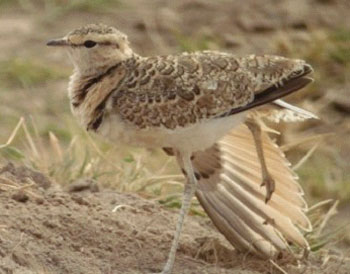 Two-banded Courser |
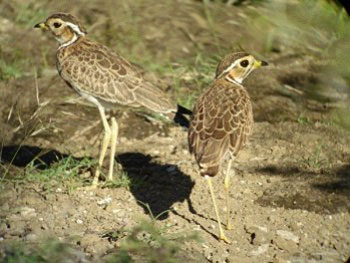 Heuglin's Courser |
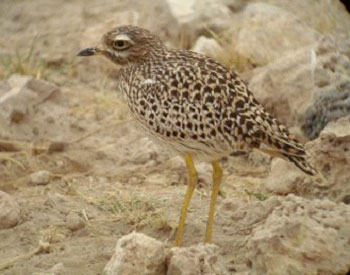 Spotted Thick-knee |
|
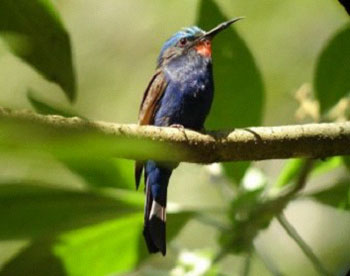 Blue-headed Bee-eater |
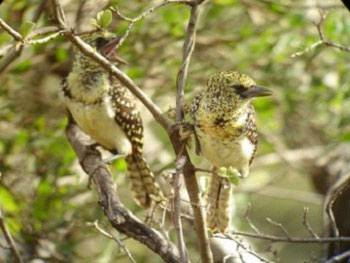 Usambiro Barbet |
||
Introduction
The complex and diverse landscapes of Kenya, has presented remarkable opportunity for avian speciation, which has been met by an extraordinary biodiversity. From Mount Kenya, to the Great Rift Valley, the Masai Mara grasslands, the arid North, the dry and bleak Amboseli basin, Lake Victoria, the jungles of the West and the coastal forests and islands, Kenya is characterised by a mosaic of environments which have evolved under the influence of altitude, complex local climate and geology.
The aim of this birding safari was to visit these varied environments to encounter the diverse birds and wildlife. The great evolutionary arms races are so dramatically played out, from the giant thorny acacias protecting themselves from bizarre looking Giraffes and Elephants to enormous man-eating felines, prehistoric crocodiles and 8 ft birds. The near 1100 species of birds (over 10% of the world species), recorded from Kenya, includes most of the major typical African families; parrots, turacos, coucals, mousebirds, wood-hoopoes, hornbills, barbets, honeyguides, cuckoo-shrikes, bulbuls, wattle-eyes, batises, bush-shrikes, helmet-shrikes and weavers etc.
Itinerary
The trip was arranged for my wife, Kate, and myself by a highly recommended, Kenyan tour company, Nature’s Wonderland Tours (www.natureswonderlandsafaris.com) and our highly recommended guides were Joseph K. Mwangi (info@natureswonderlandsafaris.com) and Chris Munene. The company provide luxury to budget safaris at a wide range of costs depending on comfort requirements.
6th August Arrive Nairobi. Thika ponds and then on to Sweetwaters.
7th August Morning at Sweetwaters and then on to Samburu.
8th August Samburu
9th August Morning at Samburu and on to Nakuru via Gatarakwa.
10th August Lake Nakuru
11th August Morning at Nakuru and then to Lake Bogoria
12th August Morning at Bogoria and on to Lake Baringo
13th August Morning at Lake Baringo and on to Saiwa Swamp.
14th August Morning at Saiwa Swamp and on to Kakemega.
15th August Kakemega and then on to Kisuma (Lake Victoria).
16th August Morning at Kisuma and then to Naivasha.
17th August Hell’s Gate National Park and Lake Naivasha.
18th August Masai Mara
19th August Masai Mara
20th August Masai Mara
21st August Drive to Amboseli
22nd August Amboseli
23rd August Tsavo West
24th August Tsavo West
25th August Drive back to Nairobi
26th August Nairobi
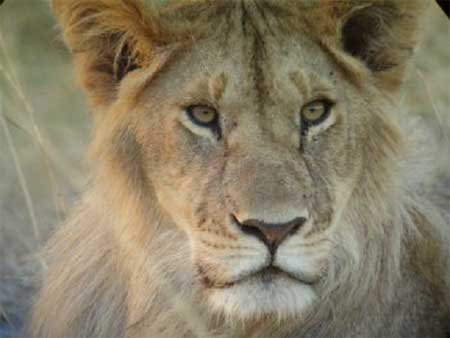
DAILY ACCOUNT
6th August - Thika Ponds
A series of sewage ponds and fresh water ponds in the vicinity of Thika were visited en route to Sweetwaters.
Characteristic/target birds seen: Painted Snipe (pair seen), Hottentot Teal, Southern Pochard, White backed Duck, Black-winged Plover, Hildebrandts Starling, Grosbeak Weaver and other waders/water birds.
7th August - Sweetwaters Game Reserve
Sweetwaters Game Reserve and Chimpanzee sanctuary are located 17km northwest of Nanyuki on part of the Laikipia Plateau. This area of wilderness is mainly acacia bushland with areas of open grassland on the leeward side of Mount Kenya. The Ewaso Ng’iro and Ewaso Narok rivers dominate this arid to semi arid landscape.
Characteristic/target birds seen: Fischers Lovebird, Brown Parrot, Saddle-billed Stork, Black-lored Babbler, Violet-backed Starling, Grey-capped Social-Weaver, Chestnut Sparrow, Rufous Sparrow and Brimstone Canary.
Other wildlife seen: Reticulated Giraffe, Common Zebra, Buffalo, Chimpanzee (sanctuary) and Black Rhino (sanctuary).
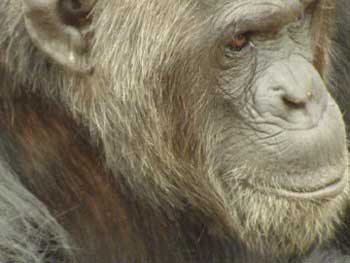
Chimpanzee, Sanctuary near Sweetwaters.
8th August - Samburu National Reserve
Samburu, Buffalo Springs and Shaba Parks are situated just north of the frontier town Isiolo within Kenya’s hot and arid northern region. The three reserves are separated by the Ewaso Ng’iro River which acts as a life giver in this semi-desert region. Around the edges of the river, acacia and doum palms dominate, being replaced by dusty scrubland outside the flood plain.
This dry, inhospitable environment hosts several bird and mammal species which are restricted to this habitat, notably the Grevy’s Zebra, Reticulated Giraffe, Long necked Gerenuk and Beisa Oryx. This macro-environmental transition marks a speciation boundary with several bird species only occurring or being replaced, namely the Somali Ostrich replacing the Common Ostrich and Taita Fiscal replacing Common Fiscal.
Characteristic/target species seen: White-headed Buffalo-Weaver, African Orange-bellied Parrot, White-bellied Bustard, Buff-crested Bustard, Pink-breasted Lark, Taita Fiscal, Red-billed Hornbill, Yellow-billed Hornbill, Bristle-crowned Starling, Black-faced Sandgrouse, Fawn-coloured Lark, Black-cheeked Waxbill, Somali Ostrich, Eastern Pale Chanting Goshawk, Rosy-patched Bush-Shrike, Banded Parisoma, Black-capped Social Weaver, Lappet-faced Vulture, Fischer’s Starling, Von der Decken’s Hornbill, Pygmy Falcon, Bateleur, Somali Bee-eater, White Backed Vulture and Donaldson-Smith’s Sparrow-weaver.
Other Wildlife seen: Grevy’s Zebra, Reticulated Giraffe, Long-necked Gerenuk, Beisa Oryx, Bushbuck, Waterbuck, Elephant, Buffalo, Dikdik, Thompson Gazelle, Grant’s Gazelle and Common Zebra.
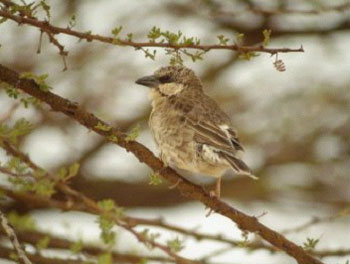
Donaldson-Smith’s Sparrow-weaver, Samburu.
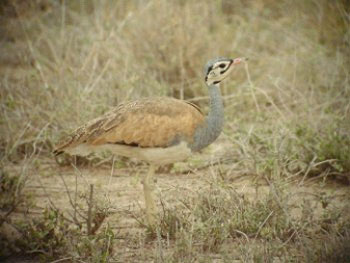
White-bellied Bustard, Samburu.
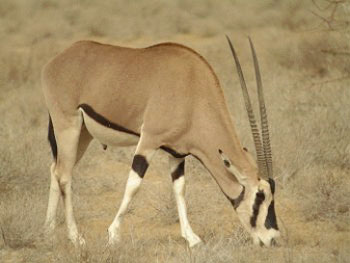
Beisa Oryx, Samburu.
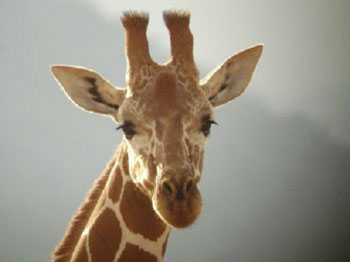
Reticulated Giraffe, Samburu.
9th August - Gatarakwa
En- route from Samburu to Nakuru, this area of farms and cliffs is host to the localised Cape Eagle Owl.
Target species seen: Cape Eagle Owl
10th August - Lake Nakuru National Park
The National Park is centred on the most famous of the Great Rift Valley alkaline lakes which plays host to immense numbers of Lesser Flamingos. These birds feed on the blue-green algae Spirulina Platensis which is prolific in the baking waters. Away from the swampy shores the habitat is replaced by dry savannah.
Characteristic/target species seen: Yellow-throated Longclaw, African Hoopoe, Northern Anteater Chat, Rufous-naped Lark, Coqui Francolin, Secretary Bird, Cliff Chat, Southern Ground Hornbill, Brown-crowned Tchagra, Arrow-marked Babbler, Black Cuckoo, White-fronted Bee-eater, Golden-breasted Bunting, Chin-spot Batis, Cinnamon-chested Bee-eater, Grey-crested Helmet Shrike, Bearded Woodpecker, Lesser Flamingo, Great Sparrowhawk and Glossy Ibis.
Other wildlife seen: Rothschild Giraffe, Colobus Monkey, Vervet Monkey, Leopard and Lion.
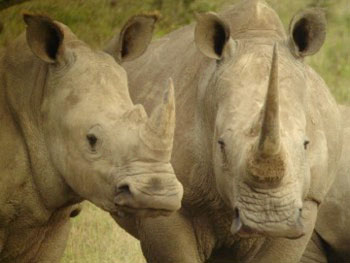
White Rhino, Lake Nakuru.
11th August - Lake Nakuru National Park
Characteristic/target species seen: Martial Eagle, Little Rock Thrush, White-bellied Tit.
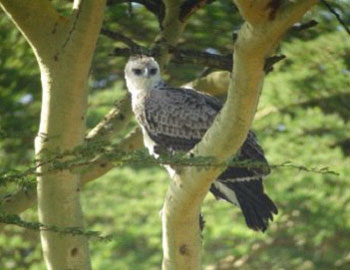
Juvenile Martial Eagle, Lake Nakuru.
Lake Bogoria National Reserve
This reserve, centred on Bogoria alkaline lake is set amongst dry scrubland and hot geysers. The lake has played host to displaced Lesser Flamingos from Nakuru and there has been several, as yet, unsuccessful breeding attempts. The muddy edges to the lake attract waders.
Characteristic/target species seen: Pygmy Kingfisher, Madagascar Bee-eater, Dark Chanting Goshawk, White-bellied Canary, Cape Teal, Black-necked Grebe, Greater Flamingo, Eastern-violet backed Sunbird, Little Weaver, Lesser Masked Weaver, Vitelline Masked Weaver, White-browed Scrub Robin, Black Throated Barbet, Knob-billed Duck, Black-headed Plover and Alpine Swift.
12th August - Lake Bogoria National Reserve
Characteristic/target species seen: Golden-backed Weaver, White-fronted Bee-eater, Open-billed Stork (migrating along valley), Rufous Chatterer, Long-toed Lapwing, Silverbird, Jackson’s Hornbill, Spot-flanked Barbet, Pearl spotted Owlet, Red-faced Crombec and Red-fronted Tinkerbird.
Lake Baringo
A fresh water lake situated to the north of Bogoria with wooded creeks and islands set against a backdrop of dramatic escarpments.
Characteristic/Target species seen: Brown Babbler, Heuglin’s Courser, Slender-tailed Nightjar, Greyish Eagle Owl, Fan-tailed Raven, Gabar Goshawk, White-faced Scops Owl, Lesser Honeyguide, Red-winged Starling, Hemprich’s Hornbill, Yellow-spotted Pretonia, Brown-tailed Rock Chat and Lanner.
Other wildlife seen: Rock hyrax
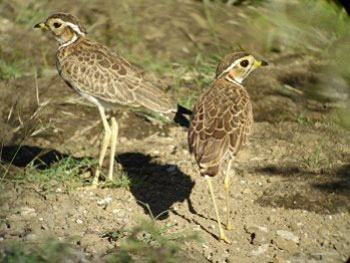
Heuglin’s Courser, Baringo.
13th August - Lake Baringo
Characteristic/target species seen: Red-chested Cuckoo, Woodland Kingfisher, Red-headed Barbet, Paradise Flycatcher (grey morph), Silverbill, Northern Masked Weaver (localised species nesting on shores of lake), Gull-billed Tern, White-winged Black Tern and Water Thick-knee.
Other Wildlife: Hippopotamus and Crocodiles.
14th August - Saiwa Swamp National Park
This national park, the smallest in Kenya, is comprised of an area of rush swamp, wooded grasslands and indigenous forest. Set up to protect the rare semi-aquatic sitatunga antelope the reserve is also host to a large range of western forest (west of the rift valley) and riverine/swamp bird species.
Characteristic/target species seen: Ross’s Turaco, Blue-spotted Wood Dove (a mainly western species), Fan-tailed Widow Bird, Yellow-mantled Bishop, Black-collared Apalis, Common Waxbill, Blue-headed Coucal, African Firefinch, Cape Wagtail, African Dusky Flycatcher, Holub’s Golden Weaver, Little Rush Warbler, Winding Cisticola, Red-faced Cisticola, Chubb’s Cisticola, Red-collared Widowbird, Yellow-whiskered Greenbul, Black-throated Wattle-eye, Purple-throated Cuckoo-shrike, Grey-headed Warbler, Green-headed Sunbird, Ludher’s Bush-shrike, Yellow white-eye, Black-billed Weaver, Grosbeak Weaver, Angola Swallow, Grey-rumped Swallow and African Citril Finch. Also Black-and-white-casqued Hornbill en route.
Other Wildlife seen: Colobus Monkey, de Brazza Monkey.
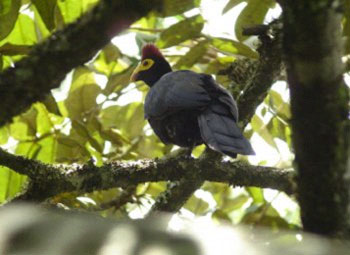
Ross’s Turaco, Saiwa Swamp.
15th August - Kakamega Forest National Reserve
This forest is a remnant of the Guineo-Conglian equatorial forest belt which once covered all land from the Atlantic to the Rift Valley. The Elgon teak tree is characteristic of the lush forest habitat which is teeming with Blue, Red-tailed and Colobus Monkeys and forest bird species found nowhere else in Kenya.
Characteristic/Target species seen or heard: Great-blue Turaco, Narina Trogon, African Broadbill, Blue-headed Bee-eater, African Shrike Flycatcher, Common Wattle-eye, Grey-winged Robin, Black-and-white-Casqued Hornbill, Double-toothed Barbet, Petite’s Cuckoo-shrike, Purple-throated Cuckoo-shrike, African Blue-flycatcher, Red-headed Malimbe, Black-necked Weaver, Dark Backed Weaver, Stuhlmann’s Starling, Shelly’s Greenbul, Bocage’s Bush-Shrike, Cabani’s Greenbul, African Emerald Cuckoo, Grey-throated Barbet, Equatorial Akalat, Snowy-headed Robin-Chat, Yellow-spotted Barbet, Slender-billed Greenbul, African Thrush, Red-tailed Bristlebill, Least’s Honeyguide, Ludhers Bush-Shrike, Grey-headed Negrofinch, Dusky Tit, White-headed Wood-hoopoe, Brown-chested Alethe, Uganda Woodland Warbler, Western Black-headed Oriole, Yellow-crested Woodpecker, Hairy-breasted Barbet, Black-faced Rufous Warbler, Black-headed Waxbill and Black-crowned Waxbill.
Other wildlife seen: Red-tailed Monkey, Blue Monkey and Colobus Monkey.
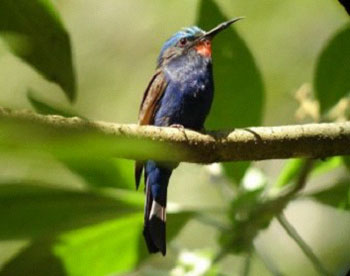
Blue-headed Bee-eater. Kakamega.
16th August - Kisumu
Situated on the shores of Lake Victoria, Kisumu is a sweltering city, with a humid climate at around 400 meters above sea level. Several bird species are local in this area including the Papyrus Gonolek (which we did not see). The lake is immense, the third largest fresh water lake in the world and is the source of the Nile.
Characteristic/target species seen at Hippo Point: Black-headed Gonolek, Carruthers’s Cisticola, Slender-billed Weaver, Northern Brown-throated Weaver, Black-and-white Cuckoo, Red-chested Sunbird, Eastern Grey Plaintain-Eater, Swamp Flycatcher, Yellow-fronted Canary, Angola Swallow, Madagascar Bee-eater, White-throated Bee-eater, Abdim’s Stork, Lanner, Great Cormorant, Openbill Stork, Woodland Kingfisher and African Fish-Eagle.
17th August - Hell’s Gate National Park
14km from Lake Naivasha, this escarpment dominated landscape is human predator free and can be explored on foot amongst Common Zebras, Elands, Masai Giraffe, Thomson’s Gazelles and Warthogs.
The escarpments provide resting ledges for mixed Swifts, Ruppell’s Vulture’s and the dramatic Verreaux’s Eagle. The habitat is mainly grass and scrubland. The endemic Schalow’s Wheatear is common.
Characteristic/target species seen: Ruppell’s Vulture, Verreaux’s Eagle, Schalow’s Wheatear, Mottled Swift, Nyanza Swift, Rock Martin, Mountain Wagtail, White-fronted Bee-eater, Cinnamon-breasted Rock Bunting, Cut-throat Finch, Crimson-rumped Waxbill, Yellow-bellied Waxbill, Violet-backed Starling, Red-winged Starling, Black-backed Puffback (heard), Brown Woodland Warbler, Cinnamon Bracken Warbler, Northern Anteater Chat, Cape Robin-Chat, Lanner and Augar Buzzard.
Lake Naivasha - A large freshwater lake with introduced game.
Characteristic/target species seen: Squacco Heron, Black-tailed Godwit, Ruff, Little Stint, Curlew Sandpiper, Avocet, Black-winged Stilt, both Pelicans, both Flamingos, Hottentot Teal, Yellow-billed Duck, Red-billed Teal, Red-knobbed Coot etc.
18th August - Masai Mara National Reserve
The Mara-Serengiti eco-system needs little introduction. This is true savannah; endless grasslands with sparse acacia and thorn, sheltering hundreds of thousands of grazing herbivores and hundreds of large cats. The Mara is an extension of the Seregenti plains which extend into bordering Tanzania. The Mara river runs north south in the park and then turns west towards Lake Victoria. It is this crocodile infested river, which hundreds of thousands of Wildebeest have to cross on their annual rain migrations. Many hundreds die on the crossing in one of the most spectacular of the Mara’s spectacles. The National Reserve has recorded over 400 species of bird.
Characteristic/target birds seen: Kori Bustard, White-bellied Bustard, Southern Ground Hornbill, Lappett-faced Vulture, White-backed Vulture, Wattled Lapwing, Red-capped Lark, Usambiro Barbet, Plain-backed Pipit, Grassland Pipit, Capped Wheatear, Sooty Chat and Banded Martin.
Other wildlife: Cheetah, Lion. Wildebeest sp, Topi, Coke’s Hartebeest, African elephant, Masai Giraffe, Thomson’s Gazelle, Grant’s Gazelle, Impala, Spotted Hyena, African Wild-Cat and Silver-backed Jackal
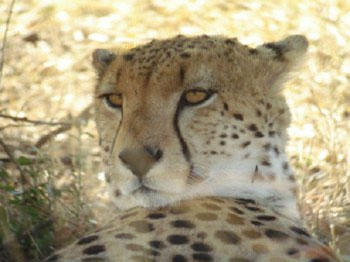
Cheetah, Masai Mara
19th August - Masai Mara
Additional characteristic/target/new bird species seen: Black-chested Snake Eagle, Temminck’s Courser, Hooded Vulture, White-backed, Ruppell’s and Lapett Faced Vulture, Bateleur, Pygmy Falcon, Magpie Shrike, Bare-faced Go-away Bird, White-necked Raven, Yellow-billed Oxpecker, Quail Finch, Coqui Francolin, Von der Decken’s Hornbill, Yellow Bishop, Purple Grenadier, White-browed Scrub Robin, White-headed Sawing, Usambiro Barbet, Red-fronted Tinkerbird, Walhberg’s Eagle, Grey Flycatcher, Silverbird and Speckle-fronted Weaver.
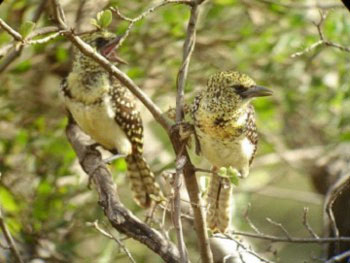
Usambiro Barbet, Masia Mara
Additional other Wildlife: Lion, Bat-eared Fox, Banded Mongoose, Topi, Wildebeest (tens of thousands), Elephant, Dik-dik, White-tailed Mongoose, Dwarf Monngosse and Spotted Hyena.
20th August - Masai Mara
Additional characteristic/new species seen: Fischer’s Sparrow Lark, Pectoral-patch Cisticola, Rosy-breasted Longclaw. Dark-chanting Goshawk, Grey-capped Social Weaver, White-headed Buffalo-Weaver, African Grey Flycatcher, African Hoopoe, Brown Parrot, Helmeted Guineafowl, Hildenbrandt’s Francolin, Lanner and Bataleur.
Additional other Wildlife: Nile Crocodile, Lion, Cheetah, Hippo and Black Rhino.
21st August - Amboseli
The journey from Masai Mara to Amboseli took most of the day arriving at the National Park at around 5pm.
Mount Kilimanjaro forms the backdrop of this impressive dry landscape, complete with desiccated wetlands, swamp elephants, dusty whirl winds, an incessant dry wind and bleak vastness. Open plains dominate with other areas of yellow acacia woodlands, palms and swamp.
The Amboseli basin is famed for it’s elephant herds with over 1000 animals in the park including 50 matriarchal families and associated bull groups.
Characteristic/target bird species seen: Chestnut-bellied Sandgrouse, Two-banded Courser, Long Tailed Fiscal, Kittlitz’s Plover, Long-toed Plover, Grey-crowned Crane, Fischer’s Starling and waterbirds in the swamp area.
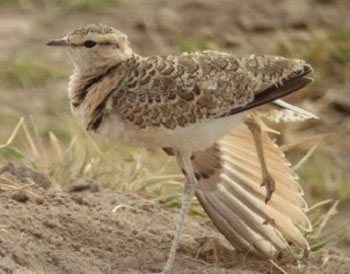
Two-banded Courser, Amboseli National Park.
Other wildlife: Golden Jackal, Spotted Hyena, Common Zebra, Wildebeest and Elephant.
22nd August - Amboseli
Additional characteristic/target birds seen: Black-bellied Bustard, Hartlaub’s Bustard, Spotted Thick-knee, Collared Pratincole, Intermediate Egret, Spur-winged Goose, White-faced Whistling Duck, Pangani Longclaw, Southern Red-Bishop and Square-tailed Nightjar (probable).
Additional wildlife: Lion, Reedbuk,
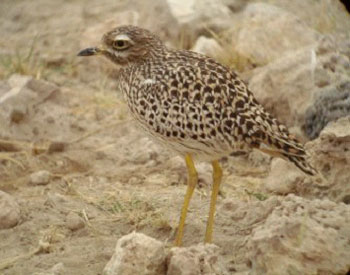
Spotted Thick-knee, Amboseli.
23rd August - Tsavo West
Tsavo West is part of the Tsavo National Park, the largest in Kenya (the size of Israel). The habitat is mainly dry acacia scrub with volcanic deserts and the occasional spring and pond.
Characteristic/target species seen: Red-billed Buffalo Weaver, Abysinnian Scimitarbill, Abysinnian White-eye, Golden-breasted Starling, Rufous Crowned Roller, Grey-headed Silverbill, Grey-headed Bush-shrike, Somali Golden Breasted Bunting, Pygmy Falcon, Van der Deckens Hornbill, Grey Hornbill, Red-billed Hornbill, Scaly Chatterer and Black-headed Batis.
Other Wildlife: Syke’s Monkey, Vervet Monkey, Spotted Hyaena, Bushbuk, Buffalo, Hippo, Elephant
24th – 25th August - Tsavo West
Additional characteristic/target species seen: Ayre’s Hawk Eagle, Shikra, Mouse-coloured Penduline Tit, Purple-banded Sunbird, Pygmy Batis, Tiny Cisticola, Three-streaked Tchgara, Hartlaub’s Bustard, African-green pigeon, Brown Snake Eagle, Pringle’s Puffback, Northern Brownbull, Shelley’s Starling, Chestnut Weaver and Brubru.
Additional Other wildlife: Lesser Kudu
26th August
Today was spent in Niarobi before heading back to London.
Outro
In total we saw 450 bird species which was reasonable for that time of year (would have approached 600 during the palearctic winter when the migrants arrive). The aim of the trip was mainly to be introduced to the birds of East Africa but also to get some photographs, see the other wildlife and get to know a bit about Kenya. Nature’s Wonderland Safaris, appreciated this balance very well and provided an all round excellent service. Thanks very much to Joseph and Chris.

www.natureswonderlandsafaris.com